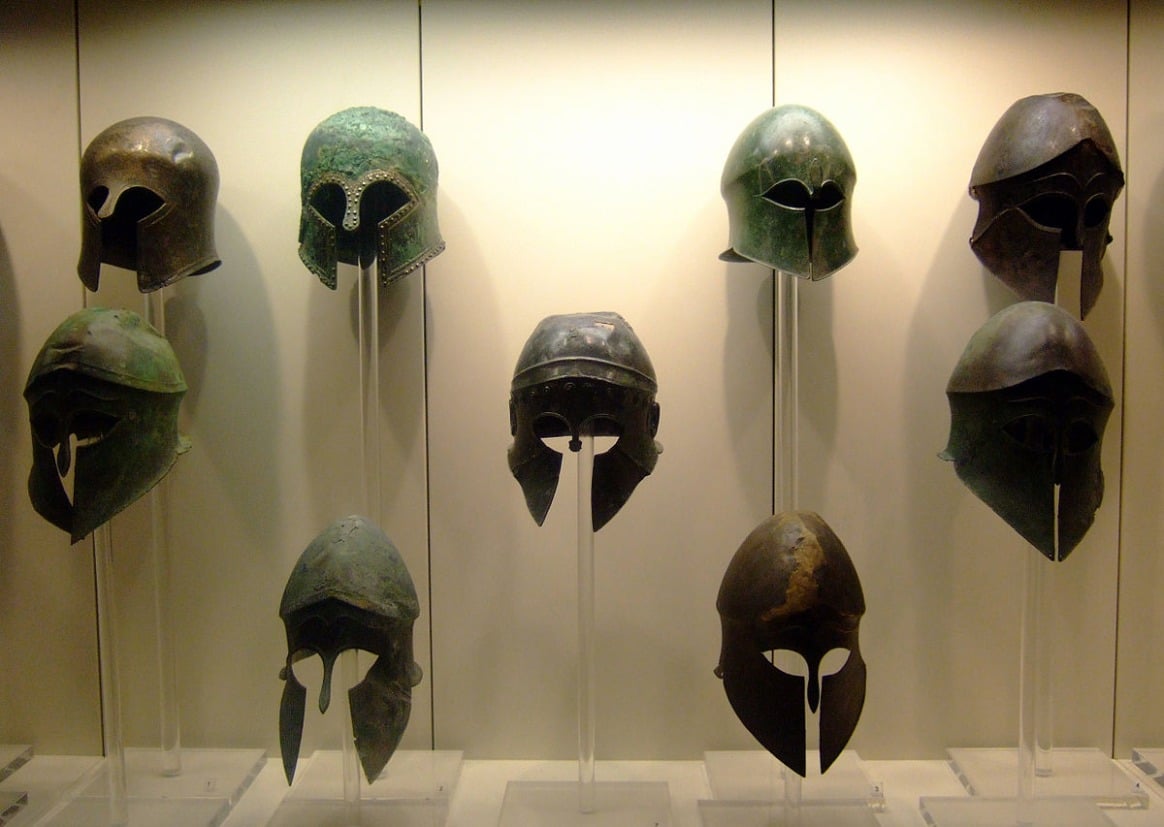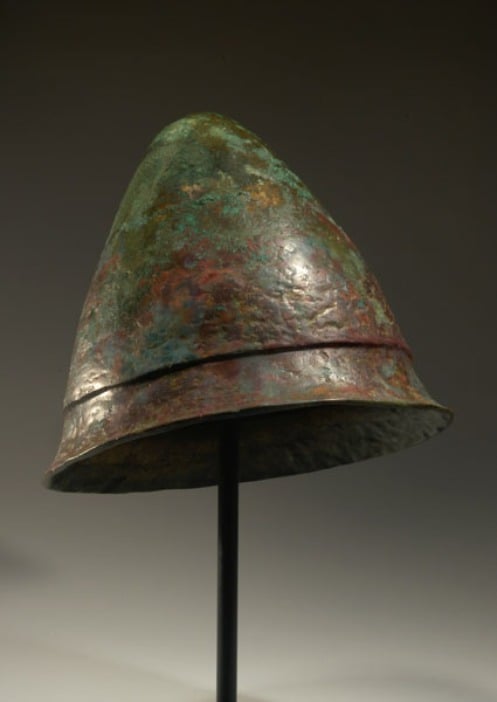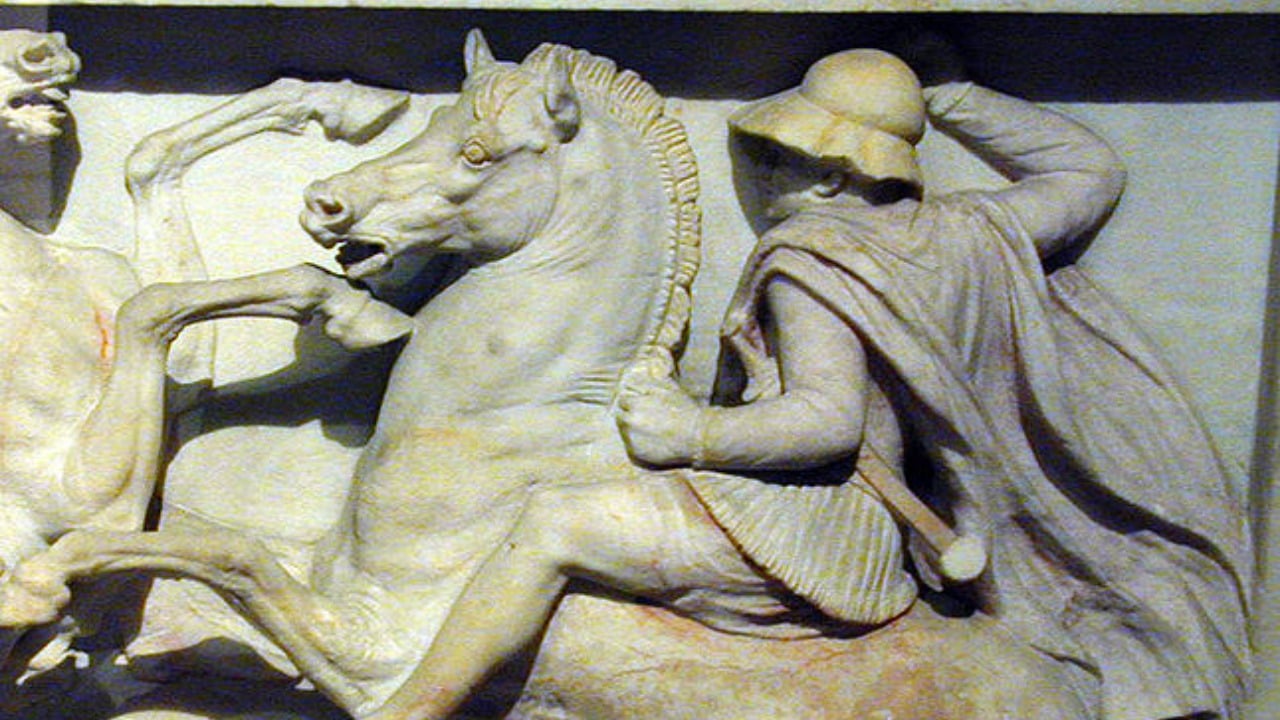
The hoplite is one of the quintessential images associated with ancient Greece, and no part of the hoplite panoply is more iconic than his helmet, made even more famous by films like 300 and Troy.
The Corinthian helmet is what most people tend to think of when they picture an ancient Greek helmet in their minds. However, over the course of history, the ancient Greeks developed and used a wide variety of helmets as the rest of their arms and armor also evolved.
Some of these armor pieces prioritized protection, whereas others sought to strike a balance between defense and situational awareness, which was also important on the battlefield. The helmets worn by wealthy and influential ancient Greeks could be highly decorative affairs, featuring colorful plumes, horsehair crests, and intricate designs, whereas those owned by the rank and file were much plainer.
The Corinthian helmet, the quintessential symbol of the Classical hoplite
The Corinthian helmet is possibly the most recognizable helmet design in history, featuring prominently on university logos, military insignias, and brands around the world.
The ancient Greeks themselves seem to have been big fans of the Corinthian type and chose to depict it in more sculptures and pottery designs than any other helmet, even after it was supplanted by other helmet designs over time.
Its heyday was in the Archaic and early Classical periods. The design appeared around the end of the 8th century BC and was used in some capacity until the 1st century AD.
The main advantage of the helmet, besides its obvious aesthetic appeal, was that it offered the wearer a superior degree of protection. Most variants of the helmet provided coverage for the whole head and face, although this came at the cost of situational awareness since vision and hearing were impaired.

The Pilos helmet, the ugly duckling of ancient Greek helmets
Although the Spartans are most closely associated with the iconic Corinthian helmet in the popular imagination, largely due to Gerard Butler’s depiction of Leonidas in the movie 300, some historians have theorized that from around the 5th century BC, they may have instead opted for the humble Pilos helmet.
It is believed that this particular design was inspired by the pileus hat, which was commonly worn in Arhaeic and Classical Greece. The hat may have been worn under the helmet to provide extra padding and comfort.
Admittedly, the Pilos is not much to look at it and does not boast the aesthetic appeal of other ancient Greek helmets. However, it did offer an unobstructed view of the battlefield and was cheaper to manufacture than more complicated designs.

The Chalcidian helmet
The Chalcidian helmet was particularly popular in ancient Grece between the fourth and fifth centuries BC. It struck a good balance between offering its wearer protection and situational awareness in the heat of battle.
The modern name for this ancient Greek helmet is based on the belief that the design originated from the Euboean city of Chalcis after a piece of pottery was discovered depicting it. However, there is not much evidence as to where the design originated from. It may have been a derivative of the Corinthian helmet.
The inclusion of cheekpieces, a neck guard, and a nasal bar, meant that the Chalcidian helmet offered more protection than minimalist styles like the Pilos, but also offered greater situational awareness than the Corinthian.

The Phrygian helmet
The Phrygian helmet, sometimes referred to as the Thracian helmet, was especially favored by the infantry of Alexander the Great and was used extensively by the cavalry of his father Philip II.
The Phrygian helmet, like the Pilos, appears to have been based on a hat, typically worn by the Phrygians and Thracians. Its most distinctive feature was its high and forward-inclined apex.
If the design looks strangely familiar, it may be because the Phrygian cap was adopted as the headwear for the Smurfs in the eponymous Belgian comic series.

The Boeotian Helmet
The Boeotian helmet, like many other variants, was based on a type of hat worn in ancient Greece. This particular helmet was modeled on the folded-down Boeotian variant of the petasos, a type of Greek sun hat, commonly made of felt.
The Athenian military historian and mercenary soldier Xenophon wrote that the Boeotian helmet offered “the greatest protection to all the parts above the cuirass, but allows free vision,” making it the ideal choice for mounted soldiers.
Based on this advice, the Boeotian helmet became a popular choice for the Thessalian and Companion cavalry in the army of Alexander the Great.

The Attic helmet
The Attic helmet became popular in ancient Greece in the 4th century BC. Unlike most types of Greek helmets, it was typically made of iron rather than bronze. It was comparable in style to the Chacidian helmet but did not feature a nose bar.
The Attic helmet was used extensively outside of the ancient Greek world by other peoples as well, particularly in Italy. Prominent archaeological discoveries of the helmet have been found in Samnite and Lucanian burials in Central and Southern Italy.
The Attic helmet is also closely associated with the Romans. Roman officers and Praetorians were frequently depicted wearing the Attic helmet in Roman reliefs. Whether this was an artistic preference or accurately reflected actual Roman equipment is difficult to determine because fewer archaeological finds of Roman-style Attic helmets remain.

See all the latest news from Greece and the world at Greekreporter.com. Contact our newsroom to report an update or send your story, photos and videos. Follow GR on Google News and subscribe here to our daily email!



